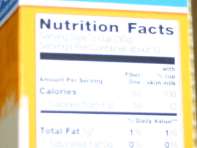|
Digital News Report – The U.S. Food and Drug Administration (FDA) is looking into changing the way food is labeled, specifically the nutrition labels. The agency is also considering requiring the labels on the front rather than the rear or side of the package.
The FDA will try to make the serving sizes reflect the way Americans eat. Rather than forcing consumers to multiply everything on the label by two or three, the FDA is considering making some servings larger.
An article by Lolita Carrico in Fit Gloss says the FDA is considering changes to fight obesity. Labels on the front of the package may “shock” consumers into losing weight.
William Neuman in the New York Times calls these changes a “strategy” against obesity. “The goal is to give people a jolt of reality before they reach for another handful of chips,” Neuman said. Rather than thinking they are only eating 300 calories, consumers may realize they are really consuming 500 calories.
Related Studies:
But are the food labels accurate? A recent study by Tuffs University found that fast food restaurants under reported their calorie information 20 percent on average. It wasn’t as bad for packaged food, but calories were still labeled on average 8 percent lower.
Dr. Susan B. Roberts, professor of Nutrition Science and Policy at Tufts took meals from 29 restaurants and 10 frozen food packages and discovered the calories to be under-reported by 200 percent.
A new report published in the January 25th journal of Pediatrics found that parents selected meals with an average 102 less calories when the menus clearly showed the calories for each item.
By: Jason Chang


!: Put the fork down!
2: Get off that big arse!
Enough with the labeling nonsense! If people aren’t smart enough to know that Capt’n Crunch with marshmallows is full of sugar then they shouldn’t be part of the gene pool!
Stop trying to protect us from ourselves. If the FDA had their way the package would be three times the size of the content just to accommodate the darn required labeling!
how about labeling the product to indicate that it has GMO’s in the contents. give the consumer a choice.
Any reporting of less than 100% is not possible.